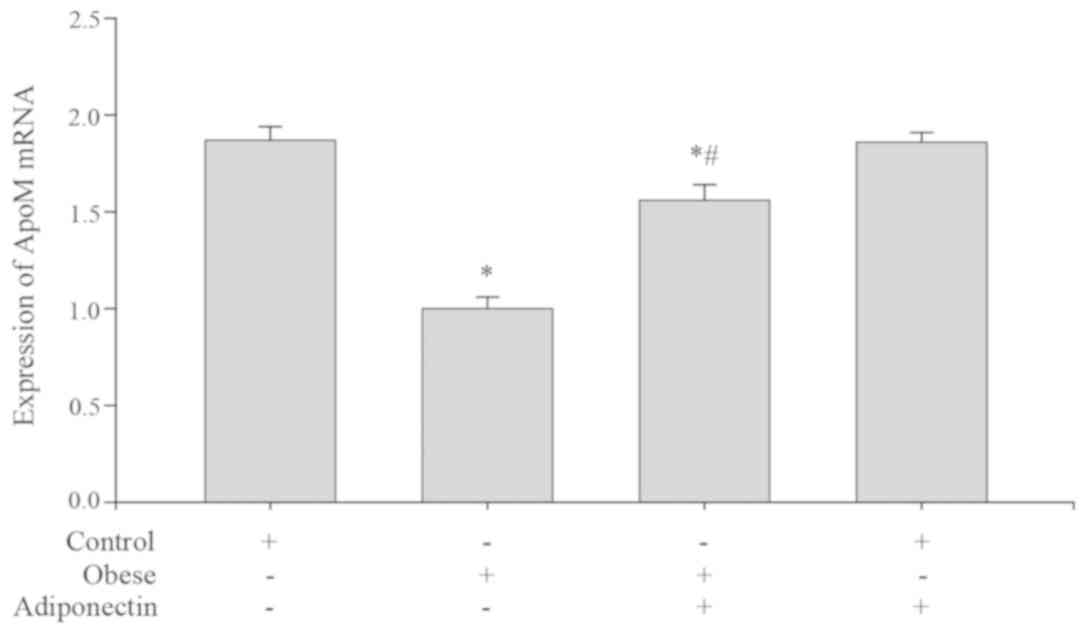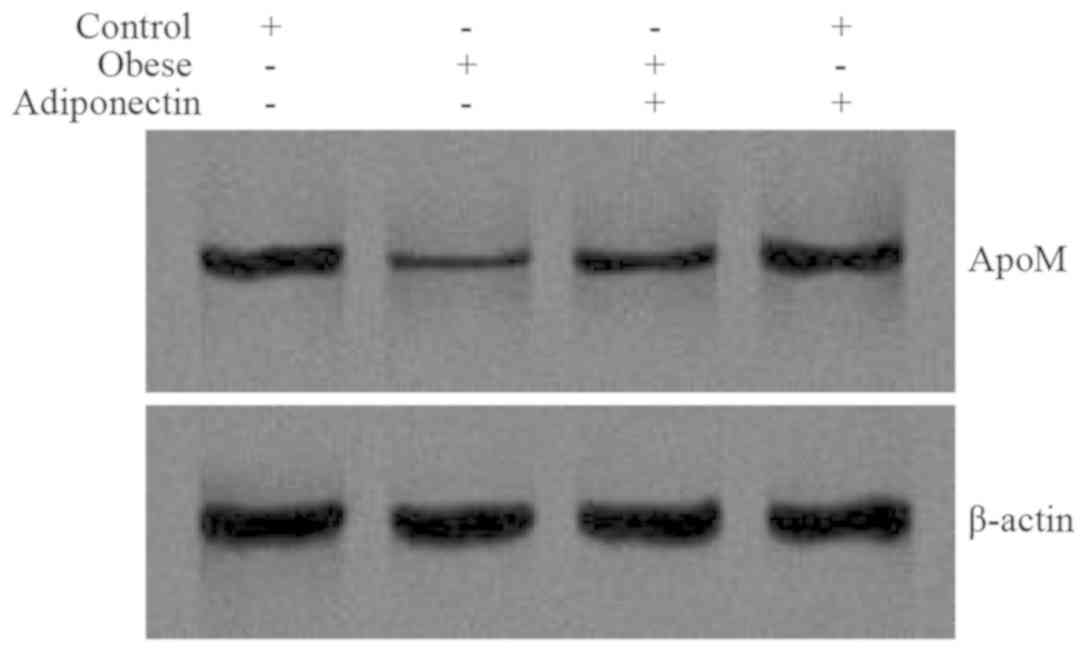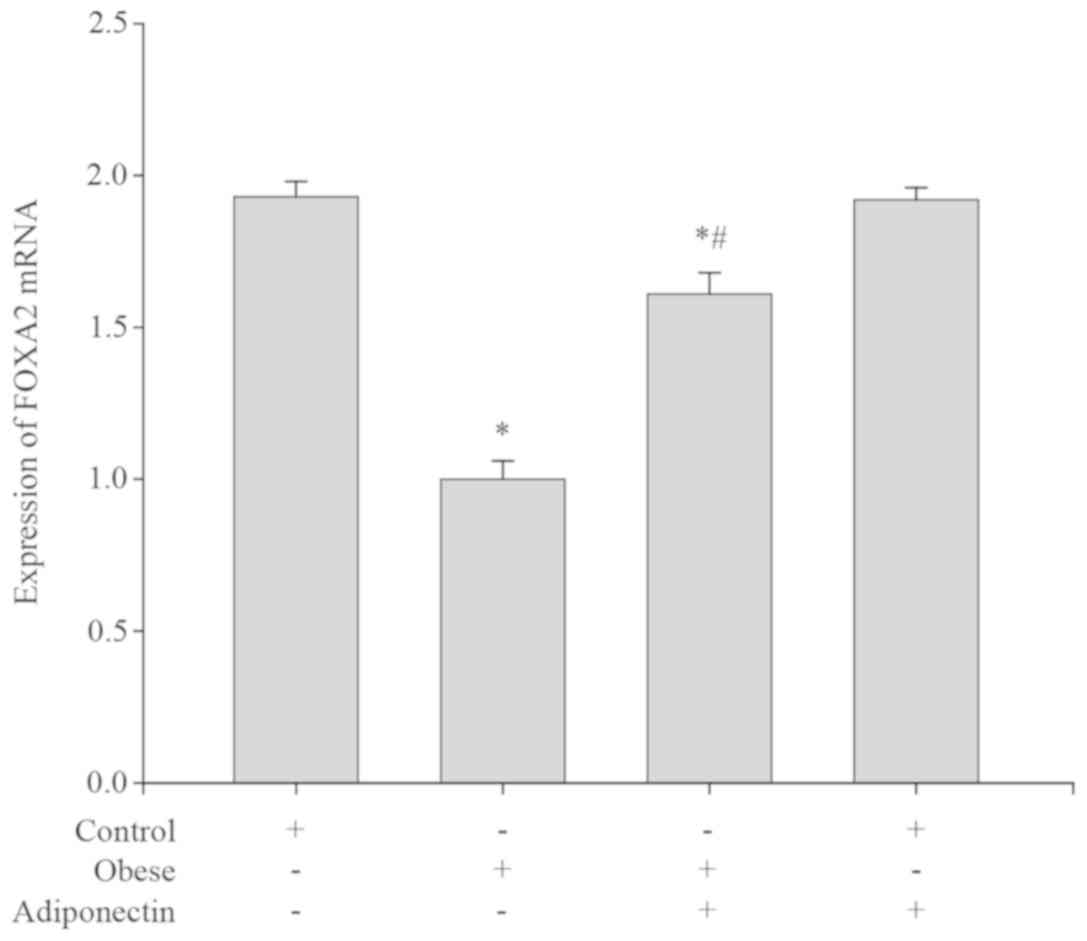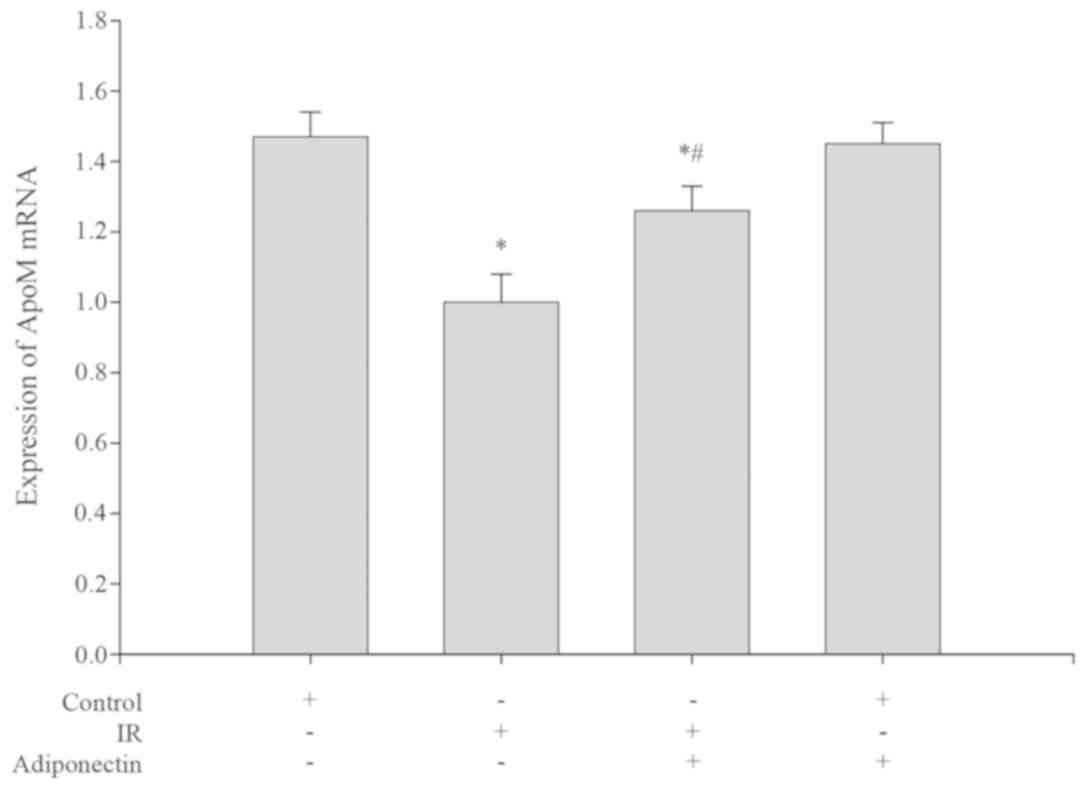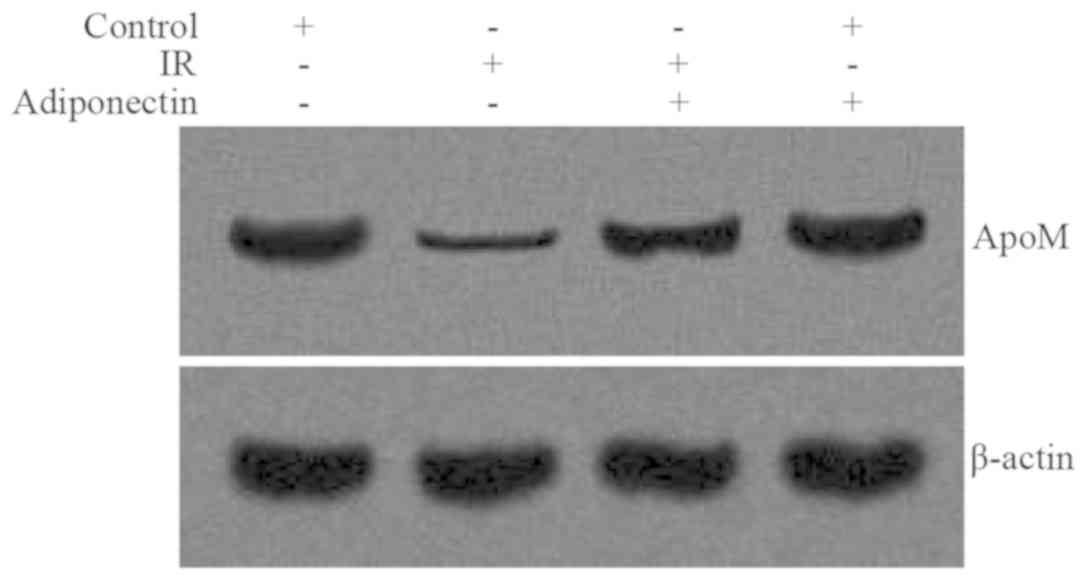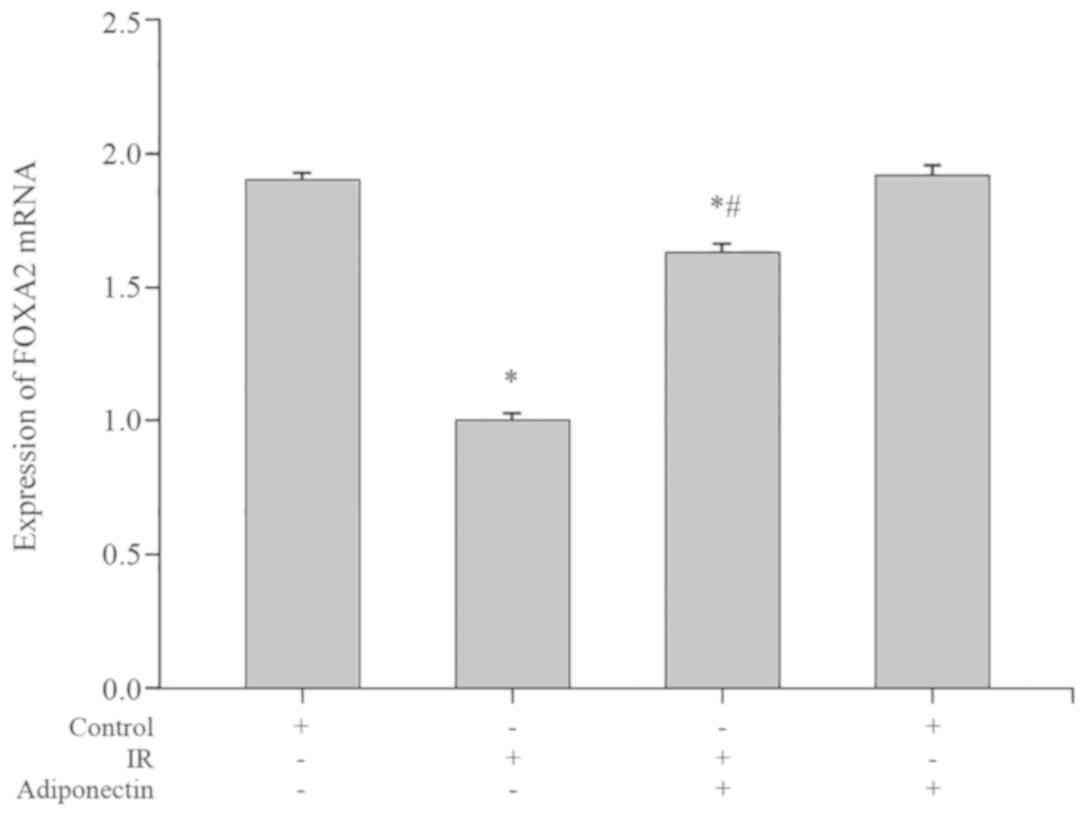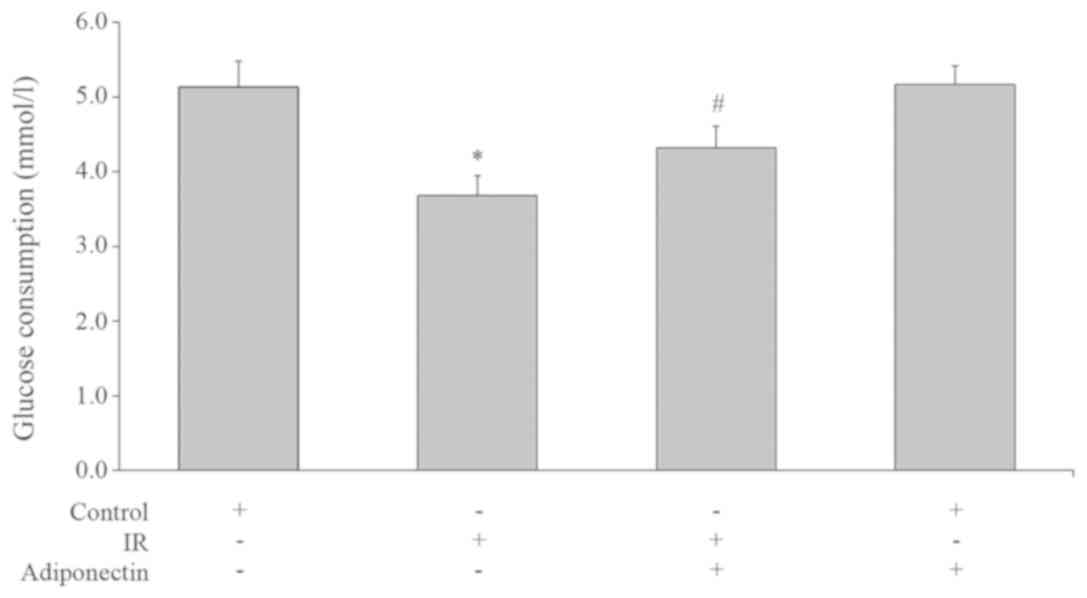|
1
|
Ravussin A and Bouchard C: Human genomics
and obesity: Finding appropriate drug targets. Eur J Pharmacol.
410:131–145. 2000. View Article : Google Scholar : PubMed/NCBI
|
|
2
|
Abbasi F, Brown BW Jr, Lamendola C,
McLaughlin T and Reaven GM: Relationship between obesity, insulin
resistance, and coronary heart disease risk. J Am Coll Cardiol.
40:937–943. 2002. View Article : Google Scholar : PubMed/NCBI
|
|
3
|
Sacks FM; Expert Group on HDL Cholesterol,
: The role of high-density lipoprotein (HDL) cholesterol in the
prevention and treatment of coronary heart disease: Expert group
recommendations. AM J cardiol. 90:139–143. 2002. View Article : Google Scholar : PubMed/NCBI
|
|
4
|
Wolfrum C, Poy MN and Stoffel M:
Apolipoprotein M is required for prebeta-HDL formation and
cholesterol efflux to HDL and protects against atherosclerosis. Nat
Med. 11:418–422. 2005. View
Article : Google Scholar : PubMed/NCBI
|
|
5
|
Everson SA, Goldbeng DE, Helmrich SP,
Lakka TA, Lynch JW, Kaplan GA and Salonen JT: Weight gain and the
risk of developing insulin resistance syndrome. Diabetes Care.
21:1637–1643. 1998. View Article : Google Scholar : PubMed/NCBI
|
|
6
|
Caro JF: Clinical review 26: Insulin
resistance in obese and nonobese man. J Clin Endocrinol Metab.
73:691–695. 1991. View Article : Google Scholar : PubMed/NCBI
|
|
7
|
Podskalny JM, Takeda S, Silverman RE, Tran
D, Carpentier JL, Orci L and Gorden P: Insulin receptors and
bioresponses in a human liver cell line (Hep G-2). Eur J Biochem.
1502:401–407. 1985. View Article : Google Scholar
|
|
8
|
Brillon DJ, Freidenberg GR, Henry RR and
Olefsky JM: Mechanism of defective insulin-receptor kinase activity
in NIDDM. Evidence for two receptor populations. Diabetes.
38:397–403. 1989. View Article : Google Scholar : PubMed/NCBI
|
|
9
|
Hari J and Roth RA: Defective
internalization of insulin and its receptor in cells expressing
mutated insulin receptors lacking kinase activity. J Biol Chem.
262:15341–15344. 1987.PubMed/NCBI
|
|
10
|
Amatruda JM and Roncone AM: Normal hepatic
insulin receptor autophosphorylation in nonketotic diabetes
mellitus. Biochem Biophys Res Commun. 129:163–170. 1985. View Article : Google Scholar : PubMed/NCBI
|
|
11
|
Changgui L, Guang N and Jialun C:
Establishing and identifing insulin resistant HepG2 cell line. Chin
J Diabetes. 7:198–199. 1999.
|
|
12
|
Xie P, Liu ML, Gu YP, Lu J, Xu X, Zeng WM
and Song HP: Oestrogen improves glucose metabolism and insulin
signal transduction in HepG2 cells. Clin Exp Pharmacol Physiol.
30:643–648. 2003. View Article : Google Scholar : PubMed/NCBI
|
|
13
|
Zhang HJ, Ji BP, Chen G, Zhou F, Luo YC,
Yu HQ, Gao FY, Zhang ZP and Li HY: A combination of grape
seed-derived procyanidins and gypenosides alleviates insulin
resistance in mice and HepG2 cells. J Food Sci. 74:H1–H7. 2009.
View Article : Google Scholar : PubMed/NCBI
|
|
14
|
Xie W, Wang W, Su H, Xing D, Pan Y and Du
L: Effect of ethanolic extracts of Ananas comosus L. leaves on
insulin sensitivity in rats and HepG2. Comp Biochem Physiol C
Toxicol Pharmacol. 143:429–435. 2006. View Article : Google Scholar : PubMed/NCBI
|
|
15
|
Haluzik M, Parízková J and Haluzík MM:
Adiponectin and its role in the obesity induced insulin resistance
and related complications. Physiol Res. 53:123–129. 2004.PubMed/NCBI
|
|
16
|
Yamashita R, Saito T, Satoh S, Kaburagi Y
and Sekihara H: Effects of dehydroepiandrosterone on gluconeogenic
enzymes and glucose uptake in human hepatoma cell line, HepG2.
Endocr J. 52:727–733. 2005. View Article : Google Scholar : PubMed/NCBI
|
|
17
|
Chavez-Tapia NC, Rosso N and Tiribelli C:
In vitro models for the study of non-alcoholic fatty liver disease.
Curr Med Chem. 18:1079–1084. 2011. View Article : Google Scholar : PubMed/NCBI
|
|
18
|
Pullinger CR, North JD, Teng BB, Rifici
VA, Ronhild de Brito AE and Scott J: The apolipoprotein B gene is
constituently expressed in HepG2 cells: Regulation by oleic acid,
albumin, and insulin, and measurement of the mRNA half life. J
Lipid Res. 30:1065–1077. 1989.PubMed/NCBI
|
|
19
|
Chao PM and Kuo YH, Lin YS, Chen CH, Chen
SW and Kuo YH: The metabolic benefits of Polygonum hypoleucum Ohwi
in HepG2 cells and Wistar rats under lipogenic stress. J Agric Food
Chem. 58:5174–5180. 2010. View Article : Google Scholar : PubMed/NCBI
|
|
20
|
Liu Z, Kuang W, Xu X, Li D, Zhu W, Lan Z
and Zhang X: Putative identification of components in Zengye
Decoction and their effects on glucose consumption and lipogenesis
in insulin-induced insulin-resistant HepG2 cells. J Chromatogr B
Analyt Technol Biomed Life Sci. 1073:145–153. 2018. View Article : Google Scholar : PubMed/NCBI
|
|
21
|
Zheng X, Ke Y, Feng A, Yuan P, Zhou J, Yu
Y, Wang X and Feng W: The Mechnism by which amentoflavone improves
insulin resistance in HepG2 cells. Molecules. 21(pii): E6242016.
View Article : Google Scholar : PubMed/NCBI
|
|
22
|
Nie J, Chang Y, Li Y, Zhou Y, Qin J, Sun Z
and Li H: Caffeic acid phenethyl ester (Propolis Extract)
ameliorates insulin resistance by inhibiting JNK and NF-κB
inflammatory pathways in diabetic mice and HepG2 cell models. J
Agric Food Chem. 65:9041–9053. 2017. View Article : Google Scholar : PubMed/NCBI
|
|
23
|
Livak KJ and Schmittgen TD: Analysis of
relative gene expression data using real-time quantitative PCR and
the 2(-Delta Delta C(T)) method. Methods. 25:402–408. 2001.
View Article : Google Scholar : PubMed/NCBI
|
|
24
|
Horowitz BS, Goldberg IJ, Merab J, Vanni
TM, Ramakrishnan R and Ginsberg HN: Increased plasma and renal
clearance of an exchangeable pool of apolipoprotein A-I in subjects
with low levels of high density lipoprotein cholesterol. J Clin
Invest. 91:1743–1752. 1993. View Article : Google Scholar : PubMed/NCBI
|
|
25
|
Ruiz M, Frej C, Holmér A, Guo LJ, Tran S
and Dahlbäck B: High-density lipoprotein-associated apolipoprotein
M limits endothelial inflammation by delivering
Sphingosine-1-phosphate to the Sphingosine-1-phosphate receptor 1.
Arterioscler Thromb Vasc Biol. 37:118–129. 2017. View Article : Google Scholar : PubMed/NCBI
|
|
26
|
Ruiz M, Okada H and Dahlbäck B:
HDL-associated ApoM is anti-apoptotic by delivering sphingosine
1-phosphate to S1P1 & S1P3 receptors on vascular endothelium.
Lipids Health Dis. 16:362017. View Article : Google Scholar : PubMed/NCBI
|
|
27
|
Frej C, Mendez AJ, Ruiz M, Castillo M,
Hughes TA, Dahlbäck B and Goldberg RB: A shift in ApoM/S1P between
HDL-Particles in women with type 1 diabetes mellitus is associated
with impaired anti-Inflammatory effects of the ApoM/S1P complex.
Arterioscler Thromb Vasc Biol. 37:1194–1205. 2017. View Article : Google Scholar : PubMed/NCBI
|
|
28
|
Lee M, Kim JI, Choi S, Jang Y and Sorn SR:
The effect of apoM polymorphism associated with HDL metabolism on
obese Korean Adults. J Nutrigenet Nutrigenomics. 9:306–317. 2016.
View Article : Google Scholar : PubMed/NCBI
|
|
29
|
Calabro P and Yeh ET: Obesity,
inflammation, and vascular disease: The role of the adipose tissue
as an endocrine organ. Subcell Biochem. 42:63–91. 2007. View Article : Google Scholar : PubMed/NCBI
|
|
30
|
Xu N, Nilsson-Ehle P, Hurtig M and Ahrén
B: Both leptin and leptin-receptor are essential for apolipoprotein
M expression in vivo. Biochem Biophys Res Commun. 321:916–921.
2004. View Article : Google Scholar : PubMed/NCBI
|
|
31
|
Luo G, Hurtig M, Zhang X, Nilsson-Ehle P
and Xu N: Leptin inhibits apolipoprotein M transcription and
secretion in human hepatoma cell line, HepG2 cells. Biochim Biophys
Acta. 1734:198–202. 2005. View Article : Google Scholar : PubMed/NCBI
|
|
32
|
Tsubakio-Yamamoto K, Sugimoto T, Nishida
M, Okano R, Monden Y, Kitazume-Taneike R, Yamashita T, Nakaoka H,
Kawase R, Yuasa-Kawase M, et al: Serum adiponectin level is
correlated with the size of HDL and LDL particles determined by
high performance liquid chromatography. Metabolism. 61:1763–1770.
2012. View Article : Google Scholar : PubMed/NCBI
|
|
33
|
Altinova AE, Toruner F, Bukan N, Yasar DG,
Akturk M, Cakir N and Arslan M: Decreased plasma adiponectin is
associated with insulin resistance and HDL cholesterol in
overweight subjects. Endocr J. 54:221–226. 2007. View Article : Google Scholar : PubMed/NCBI
|
|
34
|
Zietz B, Herfaah H, Paul G, Ehling A,
Müller-Ladner U, Schölmerich J and Schäffler A: Adiponectin
represents and independent cardiovascular risk factor predicting
serum HDL-C levels in type 2 diabetes. FEBS Lett. 545:103–104.
2003. View Article : Google Scholar : PubMed/NCBI
|
|
35
|
Dullaart RP, de Vries R, van Tol A and
Sluiter WJ: Lower plasma adiponectin is a marker of increased
intima-media thickness assiciated with type 2 diabetes mellitus and
with male gender. Eur J Endocrinol. 156:387–394. 2007. View Article : Google Scholar : PubMed/NCBI
|
|
36
|
Sund NJ, Vatamaniuk MZ, Casey M, Ang SL,
Magnuson MA, Stoffers DA, Matschinsky FM and Kaestner KH:
Tissue-specific deletion of Foxa2 in pancreatic beta cells results
in hyperinsulinemic hypoglycemia. Genes Dev. 15:1706–1715. 2001.
View Article : Google Scholar : PubMed/NCBI
|
|
37
|
Lee CS, Friedman JR, Fulmer JT and
Kaestner KH: The initiation of liver development is dependent on
Foxa transcription factors. Nature. 435:944–947. 2005. View Article : Google Scholar : PubMed/NCBI
|
|
38
|
Wolfrum C, Howell JJ, Ndungo E and Stoffel
M: Foxa2 activity increases plasma high density lipoprotein levels
by regulating apolipoprotein M. J Biol Chem. 283:16940–16949. 2008.
View Article : Google Scholar : PubMed/NCBI
|















